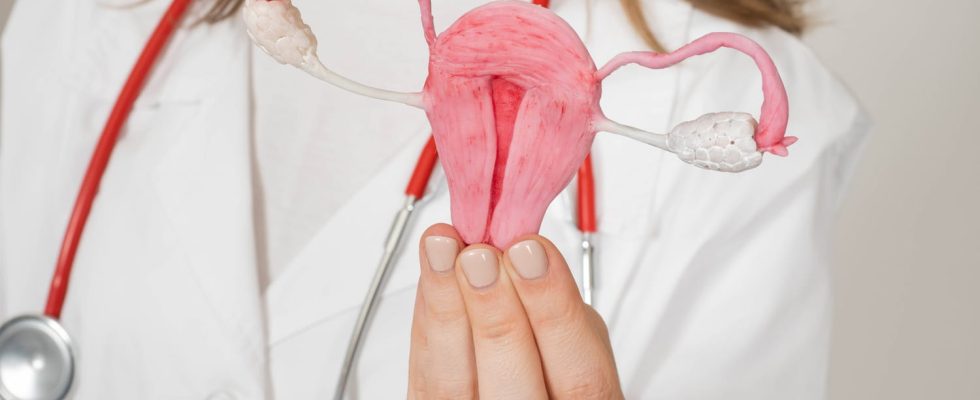An interstitial fibroma, also called interstitial leiomyoma, is a benign tumor that grows in the smooth muscle tissue of the uterus, known as the myometrium. It is the most common type of uterine fibroid in women of childbearing age. What are the different treatments?
What is an interstitial fibroma?
The uterine muscle may be the seat of a fibroid, i.e. a benign muscle cell tumor. This fibroid is fully embedded in the muscle. It does not pose a risk of becoming cancerous. Interstitial fibroids can vary in size and number. “They can be small and asymptomatic, or they can become bulky and cause symptoms such as heavy menstrual bleeding, pelvic pain, abdominal pressure, and urinary problems“, explains Dr. Hélène Pol, gynecologist-obstetrician. Interstitial fibroids can also affect fertility in some cases. “The diagnosis of interstitial fibroids is usually made by a Pelvic ultrasound or other imaging tests such as MRI“. Treatment depends on several factors, including the size and symptoms associated with fibroids, the woman’s age and her wishes for future fertility. “Treatment options may include careful monitoring, medications to relieve symptoms, fibroid reduction procedures, or in some cases surgical removal of part or all of the uterus (hysterectomy) if symptoms are severe or if fertility is not a concern“.
Is it dangerous?
In general, an interstitial fibroma is not considered dangerous. “It’s about a benign tumor, which means it is not cancerous and does not spread to other parts of the bodyreplies the doctor. Most interstitial fibroids are small and cause no symptoms, which means they don’t require often no specific treatment“However, in some cases, interstitial fibroids can cause bothersome or painful symptoms.”In rare cases, fibroids can become very large and put pressure on adjacent organs, which can lead to complications“. Also, if a woman wishes to conceive a child, the presence of interstitial fibroids can sometimes lead to fertility problems or increase the risk of complications during pregnancy.
In many cases, fibroids can stabilize or shrink naturally over time
What is the cause of an interstitial fibroma?
The exact cause of interstitial fibroids is not fully known. “However, estrogen and progesteronethe female hormones produced by the ovaries, seem to play a role in the growth of fibroids, observes our interlocutor. Interstitial fibroids are more common during the reproductive yearswhen estrogen levels are high, and tend to decrease after menopause, when estrogen levels decrease“. There is also evidence to suggest that some genetic predispositions may be involved in the development of fibroids. “Women with a family history of fibroids have a slightly higher risk of developing them“. Other factors such as obesity, hormonal imbalance, immune system disturbances and chronic inflammation may also be associated with the development of interstitial fibroids, although their exact relationship is not yet clearly defined. “It should be noted that interstitial fibroids are not caused by sexually transmitted infections, and they are not considered to be directly related to an increased risk of uterine cancer.“.
Are there any symptoms?
Interstitial fibroids can cause various symptoms in women. “However, it is important to note that some interstitial leiomyomas may be asymptomatic and be discovered incidentally during a medical examination”recognizes Dr. Pol.
Some of the most common symptoms associated with interstitial leiomyomas include: periods that are excessively heavy, prolonged, and sometimes accompanied by blood clots. “This can lead to a anemia in some women. Interstitial fibroids can cause pelvic pain or a feeling of pressure in the pelvic area. “The pain can vary in intensity and can be continuous or intermittent. Large interstitial fibroids can put pressure on the bladder, which can lead to increased urinary frequency and a feeling of urgent need to urinate. Likewise, they can cause a feeling of pressure or swelling in the abdomen. They can also cause pain or discomfort during sex (dyspareunia). “In some cases, interstitial leiomyomas can affect fertility by interfering with the implantation of an embryo or by blocking the fallopian tubes”.
What exams to diagnose an interstitial fibroma?
Several tests may be requested to diagnose an interstitial fibroma. “First of all, a pelvic exam allows the doctor to detect any abnormalities or palpable masses in the uterus“, notes the gynecologist. The doctor can use his hands to examine the uterus and pelvic organs. Pelvic ultrasound is often used as the first step in diagnosing fibroids. “It visualizes the internal structures of the uterus using sound waves. Ultrasound can identify the presence of fibroids, their size, location, and other characteristics“. MRI can provide more detailed images of the uterus and fibroids. Finally, hysteroscopy is a procedure that allows you to directly observe the inside of the uterus using a hysteroscope. “This helps identify the presence of fibroids and visualize their location and size. An endometrial biopsy may also be performed during this procedure to rule out other conditions.”
Treatment of interstitial fibroids depends on several factors, such as size, location, symptoms, age of the patient and her desire for future fertility. “If the fibroids are small, asymptomatic, or not causing major problems, a watchful waiting approach may be takenconfirms the doctor. In many cases, fibroids can stabilize or shrink naturally over time, especially after menopause“. Some medications may be prescribed to relieve symptoms related to fibroids. “Nonsteroidal anti-inflammatory drugs (NSAIDs) can help relieve pain. Ihormonal contraceptives, such as birth control pills, can reduce heavy menstrual bleeding“.”Different procedures can be considered to specifically target fibroids while preserving the uterus, such as uterine fibroid embolization (UFE) which involves blocking the blood vessels that supply the fibroids, or radiofrequency myolysis which uses thermal energy to destroy fibroids“. If the symptoms are severe or the fibroids are large, surgery may be recommended. “Different options surgical can be considered, such as myomectomy (surgical removal of fibroids while preserving the uterus), or in some cases, hysterectomy (removal of the uterus)“. Each treatment has benefits, risks and implications to consider, especially with regard to future fertility.
Thanks to Dr Hélène Pol, gynecological surgeon at the CHU Paul de Viguier in Toulouse.
